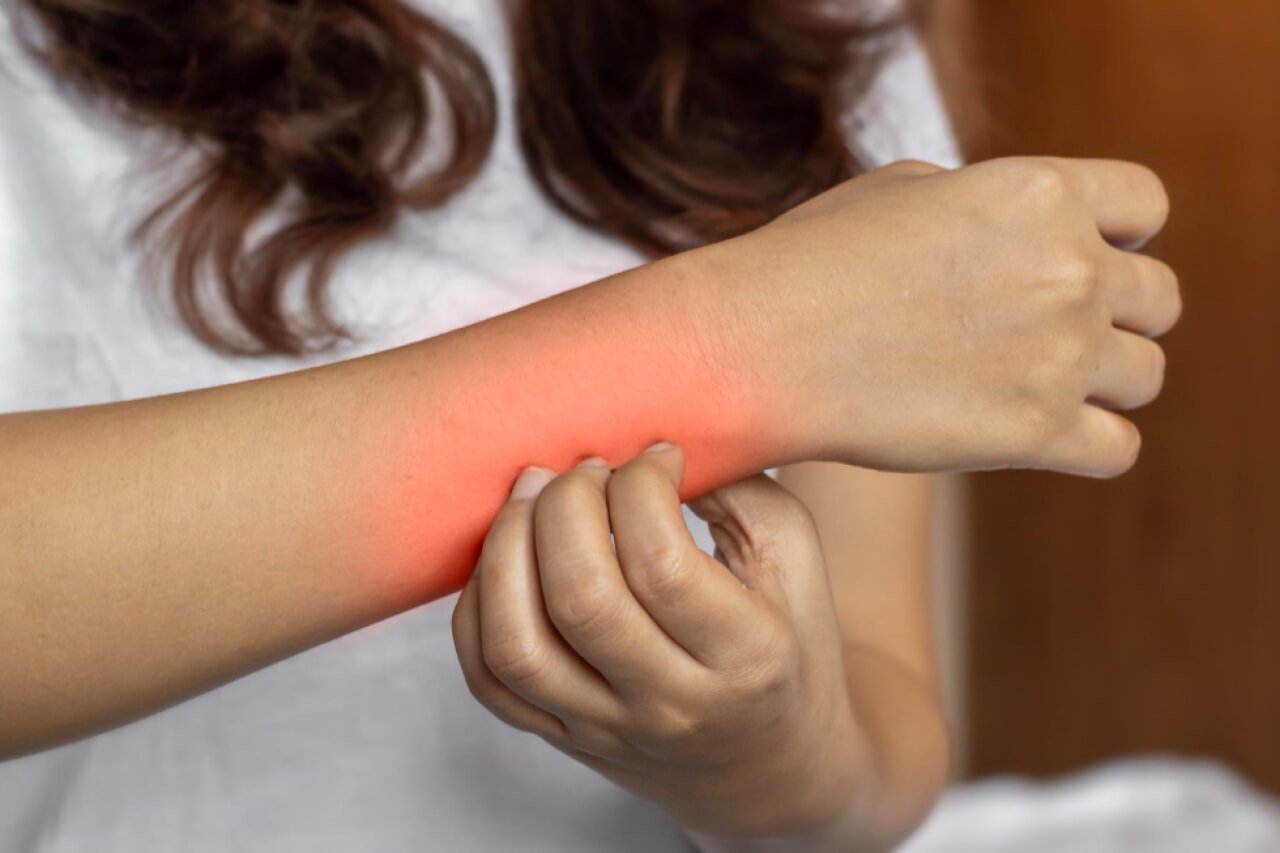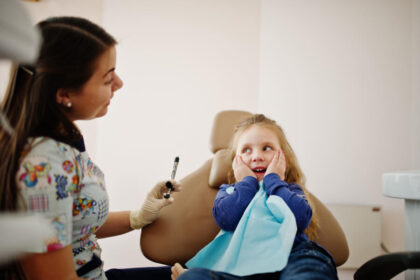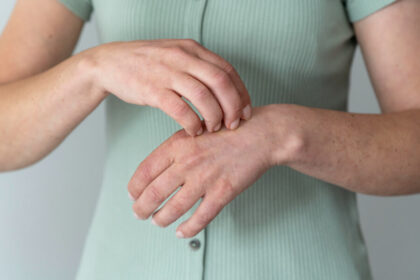What is scabies?
Scabies is a contagious skin infestation caused by a tiny mite called Sarcoptes scabiei.
These mites burrow into the upper layer of the skin, laying eggs and causing an allergic reaction, resulting in intense itching and a characteristic rash.
Scabies is usually transmitted through close personal contact with an infected person.
This can happen through prolonged skin-to-skin contact, such as living in the same household, sexual contact, or even sharing infested clothing or bedding.
If left untreated, scabies can persist for a long time and lead to secondary infections due to scratching.
What are the symptoms?
The symptoms may vary in severity and can include:
Intense Itching
The hallmark symptom is severe itching, especially at night.
The itching is typically worse in areas where the mites have burrowed into the skin.
Skin rash
A red, raised rash may develop, often accompanied by small blisters or pimple-like bumps.
The rash usually appears between fingers, on the wrists, elbows, armpits, breasts, genital area, buttocks, and waistline.
In infants and young children, the rash can also affect the face, scalp, palms, and soles of the feet.
Burrows
In some cases, thin, pencil-like burrows may be visible on the skin.
These burrows are a result of the mites tunneling just beneath the surface of the skin.
Sores and Crusts
Prolonged infestations can lead to scratching and the development of open sores or crusts on the skin. These sores may become infected, causing additional symptoms like pain and inflammation.
Generalized Itching
In some cases, scabies infestation can lead to generalized itching and rashes all over the body.
This is more common in individuals with a weakened immune system or in those with complications arising.
It’s important to note that symptoms may take several weeks to appear in individuals who haven’t had a previous infestation, while those who have previously been infested may experience symptoms more quickly.
What are the causes?
Scabies is a highly contagious skin disease caused by infestation with the parasitic mite Sarcoptes scabiei. The mites burrow into the upper layer of the skin, where they lay eggs and cause intense itching and a rash.
The most common causes include:
Close Contact
It is primarily spread through prolonged skin-to-skin contact with an infected person.
This includes sexual contact, close household or family contact, and prolonged physical contact, such as hugging or holding hands.
Crowded Living Conditions
It can easily spread in overcrowded environments, such as nursing homes, prisons, and homeless shelters.
where close contact between people is frequent and conditions for mite survival are favorable.
Contaminated Items
Scabies mites can survive for a short period away from the human body.
Infected bedding, clothing, towels, or other personal items can potentially transmit the mites if they come into contact with an uninfected person.
Weakened Immune System
People with weakened immune systems, such as those with HIV/AIDS, undergoing chemotherapy, or taking immunosuppressive medications, are more susceptible to scabies infestations.
Age and Body Parts
It can affect individuals of any age but is more common in children, as they often engage in close physical contact during play.
It is frequently found on the hands, wrists, elbows, armpits, genital area, and between the fingers.
In infants, it can also affect the scalp, face, neck, palms, and soles of the feet.
It’s important to note that personal hygiene and cleanliness are not the primary factors; it is the close contact with an infected person or infested items that poses the greatest risk.
What are the treatments?
It is typically treated with medications that kill the mites and their eggs. Common treatments for scabies include:
Medications
The most common medications treatment include:
Permethrin cream: Permethrin is a topical cream that is considered the first-line treatment.
It is applied to the entire body, from the neck down, and left on for a specified time before washing off. Permethrin kills the mites and their eggs.
Ivermectin: Ivermectin is an oral medication that may be prescribed for more severe or resistant cases of scabies.
It is generally taken as a single dose and works by killing the mites.
Crotamiton: Crotamiton is a topical lotion that can be used to relieve itching associated.
It may help in reducing the symptoms but is not as effective in killing the mites as permethrin or ivermectin.
Lindane: Lindane is a topical treatment that was commonly used in the past but is now considered a second-line or reserve treatment due to its potential neurotoxicity.
It should only be used if other treatments have failed or are not available.
It’s important to note that treatment should follow the guidance and prescription of a healthcare professional.
Home Remedies
here are some home remedies that can help alleviate symptoms:
Warm Water Soaks
Soaking in lukewarm water can help relieve itching and soothe the skin.
Add colloidal oatmeal, baking soda, or Epsom salt to the bathwater for added relief.
Tea Tree Oil
Dilute tea tree oil with a carrier oil, such as olive oil or coconut oil, and apply it directly to the affected areas.
Tea tree oil has antimicrobial properties that may help in reducing mite population and relieving itching.
Neem Oil
Neem oil has natural insecticidal properties and can be beneficial in managing scabies.
Mix neem oil with a carrier oil and apply it to the affected skin.
Leave it on for a few hours before washing it off.
Aloe Vera
Aloe vera has soothing and anti-inflammatory properties.
Apply fresh aloe vera gel directly to the affected area to relieve itching and promote healing.
Clove Oil
Clove oil has antimicrobial properties and can help in managing scabies.
Mix it with a carrier oil and apply it to the affected skin.
Remember to dilute the clove oil as it can be quite potent and may cause irritation if used undiluted.
Remember, while these remedies may provide symptomatic relief, they do not treat the underlying scabies infestation.
Conclusion
Scabies is a highly contagious skin condition caused by the microscopic mite Sarcoptes scabiei.
It is characterized by intense itching, rashes, and the appearance of burrows on the skin.
It can be transmitted through close personal contact and can spread rapidly in crowded environments.
Treatment typically involves topical creams or lotions that kill the mites and their eggs.
It is essential to treat all individuals who have come into close contact with an infected person to prevent reinfestation.
Additionally, washing or dry-cleaning infested clothing, bedding, and personal belongings is crucial to eliminate the mites.
Preventing scabies involves practicing good hygiene, avoiding direct skin-to-skin contact with infected individuals, and not sharing personal items.
Prompt identification and treatment are essential to minimize the spread and to alleviate the symptoms, such as itching and discomfort.
FAQs
What is scabies?
Scabies is a contagious skin condition caused by microscopic mites that burrow into the skin and cause intense itching.
How do you get it?
It is typically spread through close, prolonged skin-to-skin contact with an infected person.
What are the symptoms?
Common symptoms include itching (especially at night), rash, small red bumps or blisters, and the presence of burrow tracks on the skin.
How is it diagnosed?
It is often diagnosed based on the appearance and location of the rash, along with a clinical examination.
In some cases, a skin scraping may be done to confirm the presence of mites or their eggs.
Is it treatable?
Yes, it is treatable.
It is usually treated with prescription creams or lotions that kill the mites.
All close contacts should be treated simultaneously to prevent reinfestation.
Can it spread on objects or surfaces?
The mites can survive off the body for a short period, but they are unlikely to spread through contact with objects or surfaces.
Direct, prolonged skin contact is the primary mode of transmission.
How long does scabies infestation last?
If left untreated, the infestation can persist for months.
However, with proper treatment, the symptoms usually start to improve within a few days, and the infestation can be fully resolved within a few weeks.
Can you prevent scabies?
While it may not be possible to completely prevent scabies, practicing good hygiene and avoiding close contact with infected individuals can reduce the risk of transmission. Prompt treatment of any suspected scabies cases is important to prevent spreading.





